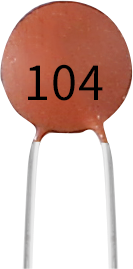Ceramic Capacitor¶

What is Ceramic Capacitor?
A fixed value type of capacitor where the ceramic material within the capacitor acts as a dielectric is the Ceramic Capacitor. This capacitor consists of more number of alternating layers of ceramic and also a metal layer which acts as an electrode.
It is widely used in electronic circuits because of its large dielectric constant, large specific capacity, wide operating range, good humidity resistance, high insulation resistance, good heat resistance, and low dielectric loss.
Features
Capacitance: 10x10^4pF (0.1uF)
Rated voltage: 50V DC
- Nominal capacity range: 80000PF~180000PF
- Test conditions:
Measurement voltage: 1±0.2Vrms
Frequency: 1KHZ
Temperature: 25±2℃(Arbitration temperature)
Allowable deviation of capacity: +80%-20%
Loss angle tangent: tgδ≤2.5×10-2
Insulation resistance (IR): ≥10000MΩ
Storage: Temperature: 0-40℃, Humidity: <80%RH
Ceramic Capacitor Polarity
When connecting capacitors in an electric circuit, capacitor polarity is one of the most important factors to consider. Based on their polarity, capacitors can be divided into two groups:
Polarised capacitor
Non-polarised capacitor
Capacitors with polarization have two terminals, called anode and cathode. They must be connected in a specific order in the circuit. And when the capacitor is non-polarized, both terminals are the same and can be connected to the circuit at will.
A ceramic capacitor is a non-polarized device that is common in every electrical device.
Following is the symbol for ceramic capacitor:

Read the capacitance value

Usually ceramic capacitors have a two to three digit code printed on them.
The first two digits describe the value of the capacitor and the last digit is a power of 10. After multiplying the first two digits together you get the capacitance value in pF.
If there are only two digits, it means there is no multiplier, then you only need to read the value of the first two digits in picofarads.
For example:
104 = 10 x 10^4=100000pF
681 = 68 x 10^1 = 680pF
Size

Outer diameter D: ф5.0±0.3mm
Lead length L: 14±1mm
Lead wire width F: 2.5±0.3mm
Wire diameter: ф0.35±0.02mm
Coating foot length C: 2.5 max
Unit Conversion
1F=10^3mF=10^6uF=10^9nF=10^12pF